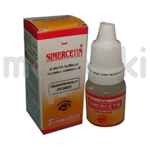Opticol Eye Drop

Opticol Eye Drop
Introduction to Opticol Eye Drop
Opticol Eye Drop is a medication used to treat bacterial infections of the eye. It contains an antibiotic that helps eliminate the bacteria causing the infection, providing relief from symptoms such as redness, swelling, and discomfort.
Composition of Opticol Eye Drop
Opticol Eye Drop contains the active ingredient Chloramphenicol, which is an antibiotic effective against a wide range of bacteria. It works by stopping the growth of bacteria, helping to clear up the infection.
Uses of Opticol Eye Drop
- Treatment of bacterial conjunctivitis (pink eye)
- Relief from symptoms of eye infections such as redness and swelling
- Prevention of bacterial infections after eye surgery
Side effects of Opticol Eye Drop
Common side effects:
- Mild stinging or burning sensation in the eyes
- Temporary blurred vision
Serious side effects:
- Severe allergic reactions such as rash, itching, or swelling
- Changes in vision
- Persistent eye irritation
Precautions of Opticol Eye Drop
Before using Opticol Eye Drop, inform your doctor if you have any allergies or medical conditions. Avoid using this medication if you are pregnant or breastfeeding unless advised by your doctor. Do not wear contact lenses while using this medication, as it may cause further irritation.
How to Take Opticol Eye Drop
- Wash your hands thoroughly before applying the eye drops.
- Tilt your head back and pull down the lower eyelid to create a small pocket.
- Hold the dropper above the eye and squeeze out the prescribed number of drops.
- Close your eyes gently and press your finger to the inside corner of the eye for about one minute.
- Do not touch the dropper tip or let it touch your eye or any other surface to avoid contamination.
Conclusion of Opticol Eye Drop
Opticol Eye Drop is an effective treatment for bacterial eye infections, providing relief from symptoms and preventing further complications. Always follow your doctor's instructions and the guidelines provided with the medication to ensure safe and effective use.
Similar Medicines
Related Faqs
Related Posts

1:15
How Do You Know If You Have a Vaginal Infection? Warning Signs!

1:15
Top Health Benefits of Cinnamon | How to Use It for Better Health!

1:15
Is Your Blood Pressure Too Low? What Are the Best Remedies to Fix Low Blood Pressure Instantly?

1:15
Mala D: How it works, When and How to take Mala D and Side Effects of Mala D!

1:15
Reduce Inflammation Naturally: Best Foods for Heart, Diabetes & Overall Health!
Disclaimer : This information is not a substitute for medical advice. Consult your healthcare provider before making any changes to your treatment . Do not ignore or delay professional medical advice based on anything you have seen or read on Medwiki.
Opticol Eye Drop
Prescription Required
Packaging :
packet of 5 ml Eye Drop
Manufacturer :
Greenco Biologicals Pvt LtdComposition :


















.svg)
